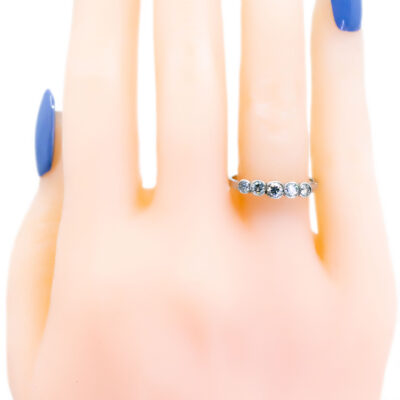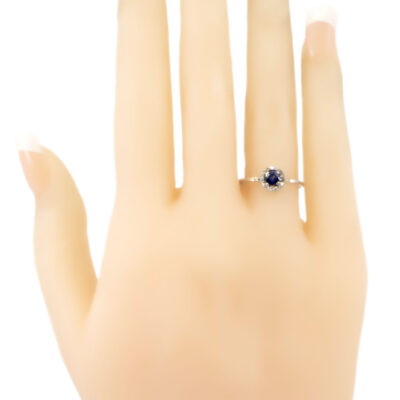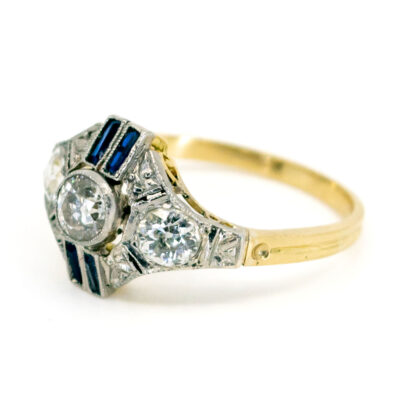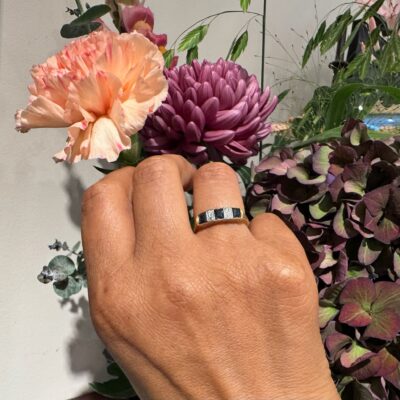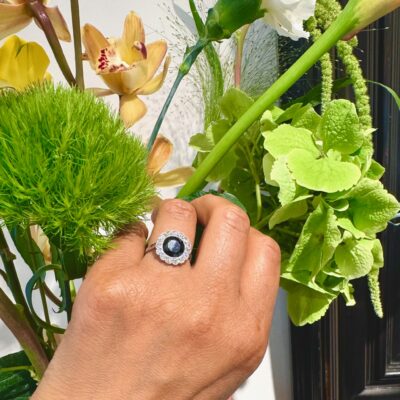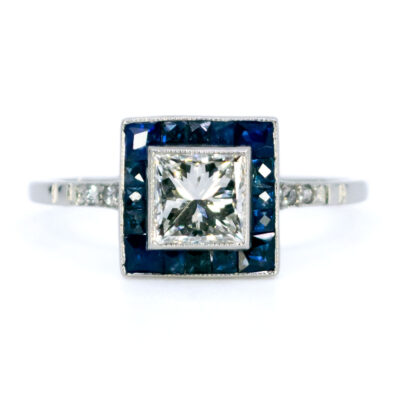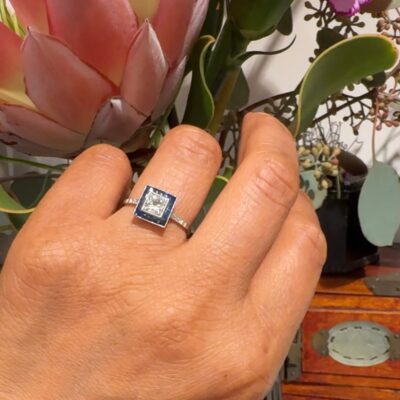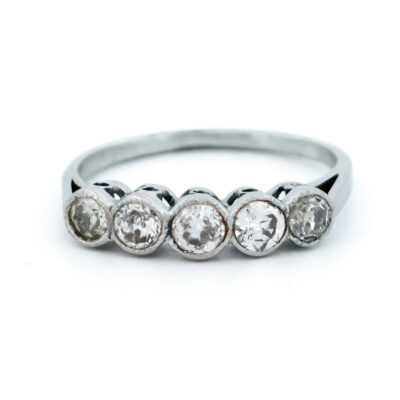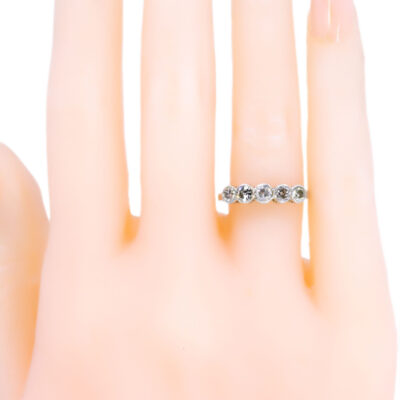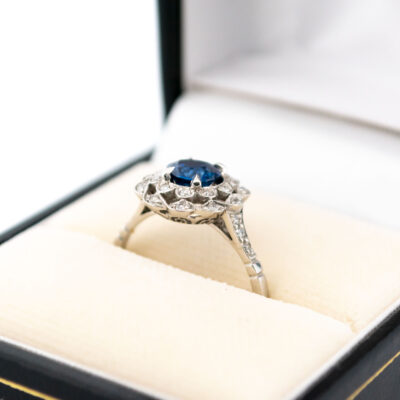This stylish row ring is made from platinum and features sapphires that weigh approximately 0.30 carats, carre cut diamonds that weigh approximately 0.20 carats (with an H VS1 grade), and brilliant cut diamonds that weigh 0.04 carats.
Videos
Details: ±0.30ct. Sapphires, ±0.20ct.( H VS1) Carre-cut diamonds, 0.04ct Brilliant-cut diamonds, Platinum Ring.
Design Era: Vintage Art Deco.
Size: 17.12 NL / 53.8 FR / 6¾ US / N UK, sizeable (Within reason. Contact seller for information).
Dimensions: H 0.3 x L 1.4 x W 0.4 cm.
Weight in grams: 2,7.
Condition: Excellent condition – barely used with minimal signs of wear.
Shipping and Pickup: This stylish piece ships from our store located in the center of Amsterdam, The Netherlands. We offer both registered shipping and local pickup at our store. In the case of local pickup, any applicable shipping costs will be refunded.
About Us: Add some sparkle to your style with Binenbaum.com. We offer a stunning selection of antique and vintage jewelry that you won’t find anywhere else. From timeless rings and dazzling necklaces to unique brooches, we have something for every taste and occasion. Visit our website today and treat yourself to a piece of history.
| Design Era | |
|---|---|
| Design & Historical Context | Art Deco jewelry, also known as Jazz Age jewelry, became popular in the 1920s and remained in style through the 1930s. It was named after the Exposition International des Arts Décoratifs et Industriels Modernes, a exhibition held in Paris in 1925 that was largely dedicated to the jewelry arts. This style was inspired by a variety of cultural and artistic movements, such as Oriental, African, and South American art, as well as Cubism and Fauvism. Art Deco jewelry is known for its sharp, straight lines and emphasis on modernity and the machine age. During the Art Deco era, there were significant improvements in diamond cutting techniques, which made diamonds more radiant and sparkling than ever before. This, along with increased prosperity, allowed more people to afford diamond jewelry and engagement rings. Additionally, new casting techniques made it possible to produce more intricate and detailed settings. Art Deco jewelry was not only fashionable but also reflected the social and cultural changes of the time. The bold, modern design of Art Deco jewelry reflected the liberation and empowerment of women during the 1920s and 1930s. Today, Art Deco jewelry is highly sought after by collectors and is often featured in museum exhibitions and high-end auctions. |
| Key Materials | |
| Materials & Craftsmanship | Sapphire: The Gem of Wisdom and Royalty Sapphire, known for its stunning deep blue color, is a gemstone that embodies wisdom, loyalty, and nobility. This precious stone is a variety of the mineral corundum, and while blue is the most famous color, sapphires can also be found in a range of hues, including pink, yellow, green, and even colorless. Historically, sapphire has been revered across cultures for its association with the divine and the eternal. In ancient Persia, it was believed that the sky was painted blue by the reflection of sapphire stones. Throughout the ages, sapphire has been favored by royalty and clergy as a symbol of purity, virtue, and divine favor. Perhaps the most famous modern example is the sapphire engagement ring worn by Princess Diana and now by the Duchess of Cambridge. In jewelry, sapphire is celebrated for its beauty and durability, boasting a Mohs hardness of 9, second only to diamond. This makes sapphire an excellent choice for rings, necklaces, and earrings intended for everyday wear. The stone’s intense color and clarity are often highlighted by settings in white gold or platinum, though yellow gold can also enhance its warmth and depth. Sapphire is more than just a gemstone; it is a symbol of wisdom, fidelity, and nobility. Its rich history, combined with its remarkable durability and beauty, makes it a timeless and elegant choice for jewelry that signifies enduring love and commitment. Carre-cut diamond: The Gem of Classic Simplicity and Subtle Elegance The carré-cut diamond is a square-shaped gemstone known for its understated elegance and clean lines. Unlike the more well-known princess or emerald cuts, the carré cut features a simple, geometric design with straight, step-cut facets that emphasize clarity and a quiet brilliance. This cut has a vintage appeal, often associated with early 20th-century jewelry designs, and is admired for its minimalist, yet refined, appearance. Historically, the carré cut dates back to the early 1900s and was popular during the Art Deco era, a time when geometric shapes and linear designs were in vogue. The cut’s name, carré, comes from the French word for square, highlighting its simple and symmetrical form. This cut was often used in antique and vintage jewelry, particularly in pieces that emphasized clean lines and architectural beauty. In modern jewelry, the carré-cut diamond is appreciated for its subtle, sophisticated look. The cut’s step facets create a soft, reflective shine rather than the intense sparkle of brilliant cuts. This makes it a popular choice for those who prefer a more understated elegance, where the diamond’s clarity and quality are showcased without overwhelming brilliance. Carré-cut diamonds are often used in eternity bands, vintage-inspired rings, and as accent stones in more elaborate designs. Because the carré cut features a large, open table, it is important to choose a stone with high clarity and color grades to ensure that any inclusions or color tints are minimized. The simple and symmetrical shape of the carré cut also lends itself well to minimalist settings, where the focus is on the stone’s natural beauty. A carré-cut diamond is more than just a gemstone; it is a symbol of timeless simplicity and refined elegance. Its clean lines and subtle brilliance make it a perfect choice for those who appreciate classic design and the beauty of understated luxury. Whether used in a vintage piece or a contemporary design, the carré-cut diamond offers a unique and elegant option for jewelry that speaks to both history and modern style. Brilliant-cut diamond: The Pinnacle of Sparkle and Brilliance The brilliant-cut diamond is the most popular and widely recognized diamond cut in the world, renowned for its exceptional sparkle and fire. This cut, perfected over centuries, is designed to maximize the reflection of light, creating the dazzling brilliance that has made it the standard for diamonds in modern jewelry. The brilliant cut features 58 facets—33 on the crown and 25 on the pavilion—carefully arranged to capture and reflect light from every angle. The precision of these facets ensures that light entering the diamond is reflected internally and dispersed into a stunning array of colors, giving the stone its characteristic brilliance. Historically, the brilliant cut evolved from earlier cuts like the Old European and rose cuts, with advancements in diamond cutting technology and understanding of light reflection. This modern cut became widely adopted in the early 20th century and quickly became the preferred choice for engagement rings and other fine jewelry, due to its unmatched sparkle. In modern jewelry, brilliant-cut diamonds are prized for their versatility and unmatched brilliance. They are the go-to choice for engagement rings, earrings, pendants, and virtually any jewelry piece where a classic, sparkling diamond is desired. The round shape and symmetrical design make the brilliant cut ideal for showcasing the inherent beauty of the diamond, regardless of its size. A brilliant-cut diamond is more than just a gemstone; it is a symbol of timeless beauty and perfection. Its unparalleled sparkle and universal appeal make it the quintessential choice for jewelry that celebrates life's most precious moments. Platinum: The Metal of Endurance and Prestige Platinum, a rare and precious metal, is renowned for its exceptional strength, purity, and enduring beauty. With its naturally white luster and remarkable resistance to tarnish and corrosion, platinum has become synonymous with luxury and durability in the world of fine jewelry. Historically, platinum has been valued for its rarity and unique properties. Ancient Egyptians and Pre-Columbian civilizations used platinum in their ceremonial jewelry, though its full potential wasn’t realized until the 18th century. By the 20th century, platinum became the metal of choice for royalty and high society, particularly in engagement rings and fine jewelry, due to its ability to securely hold precious gemstones. In modern jewelry, platinum is highly prized for its hypoallergenic properties and its ability to withstand daily wear without losing its brilliance. Its density and weight give it a luxurious feel, while its purity—often 95% pure—makes it an ideal setting for diamonds and other gemstones. Platinum's naturally white sheen enhances the sparkle of gems, and its durability ensures that jewelry pieces crafted in platinum can be passed down through generations. Platinum is more than just a metal; it is a symbol of strength, rarity, and timeless elegance. Its unmatched durability and sophisticated appearance make it the ultimate choice for those seeking jewelry that lasts a lifetime while maintaining its prestige and beauty. |
| Size | |
| Dimensions | H 0.3 x L 1.4 x W 0.4 cm |
| Gender | |
| Weight (in grams) | 2,7 |
| Condition | Excellent condition – barely used with minimal signs of wear |
By following these tips, you can enjoy your precious jewelry for many years to come.
Related Products
-
Diamond Platinum Row Ring 14454-7105
€ 1.695,00 VAT incl. (where applicable) -
Sapphire Diamond 18k Platinum Cluster Ring 5873-0629
€ 995,00 VAT incl. (where applicable) -
Diamond Platinum Sapphire 14k Deco Ring 11510-2295
€ 3.395,00 VAT incl. (where applicable) -
Sapphire Diamond 14k Row Ring 16615-8899
€ 1.695,00 VAT incl. (where applicable) -
Diamond Sapphire Platinum Cluster Ring 15873-8662
€ 3.895,00 VAT incl. (where applicable) -
Diamond Sapphire Platinum Square-Shape Ring 11550-1961
€ 5.595,00 VAT incl. (where applicable) -
Diamond Platinum Row Ring 385-0458
€ 1.695,00 VAT incl. (where applicable) -
Sapphire Diamond Platinum Cluster Ring 15482-2451
€ 4.295,00 VAT incl. (where applicable)
- Home
- Collection
- Fine Jewelry
- Silver Jewelry
- Silverware
- Boxes
- Candlesticks
- Salt and pepper shakers
- Miniatures
- Salt cellars
- Spoon Set
- Condiments
- Frames
- Napkin Ring
- Spoon
- Oddities
- Cups
- Vases
- Cutlery
- Serving Spoon And Cake Server
- Candlesticks
- Baskets
- Hanukkiah
- Spice Tower
- Yad
- Tea Set
- Sugar Castor
- Napkin Rings
- Wine Bottle Coaster
- Wine Stopper
- Tea Pot
- Jugs
- Rattles
- Hip Flask
- Miscellaneous
- Rings 💍
- About
- Contact






